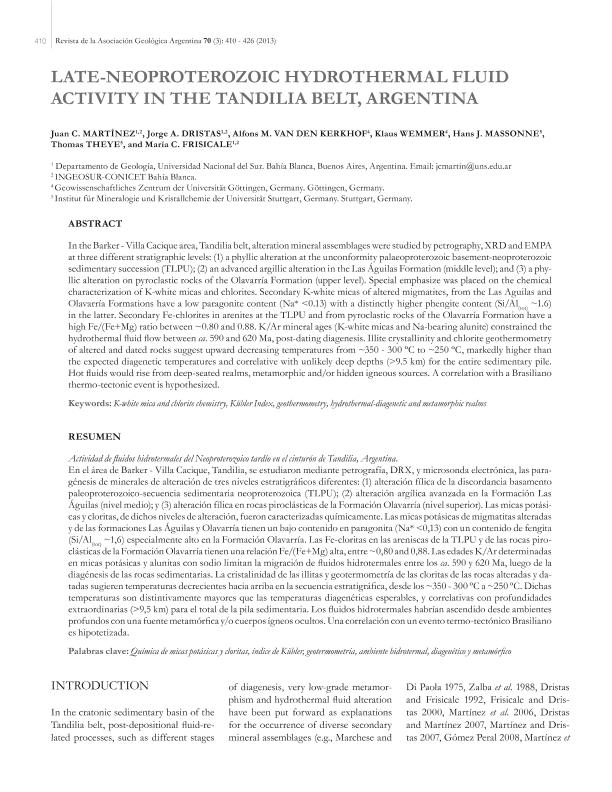Artículo
In the Barker - Villa Cacique area, Tandilia belt, alteration mineral assemblages were studied by petrography, XRD and EMPA at three different stratigraphic levels: (1) a phyllic alteration at the unconformity palaeoproterozoic basement-neoproterozoic sedimentary succession (TLPU); (2) an advanced argillic alteration in the Las Águilas Formation (middle level); and (3) a phyllic alteration on pyroclastic rocks of the Olavarría Formation (upper level). Special emphasize was placed on the chemical characterization of K-white micas and chlorites. Secondary K-white micas of altered migmatites, from the Las Aguilas and Olavarría Formations have a low paragonite content (Na* <0.13) with a distinctly higher phengite content (Si/Al(tot) ~1.6)in the latter. Secondary Fe-chlorites in arenites at the TLPU and from pyroclastic rocks of the Olavarría Formation have a high Fe/(Fe+Mg) ratio between ~0.80 and 0.88. K/Ar mineral ages (K-white micas and Na-bearing alunite) constrained the hydrothermal fluid flow between ca. 590 and 620 Ma, post-dating diagenesis. Illite crystallinity and chlorite geothermometry of altered and dated rocks suggest upward decreasing temperatures from ~350 - 300 ºC to ~250 ºC, markedly higher than the expected diagenetic temperatures and correlative with unlikely deep depths (>9.5 km) for the entire sedimentary pile. Hot fluids would rise from deep-seated realms, metamorphic and/or hidden igneous sources. A correlation with a rasiliano thermo-tectonic event is hypothesized. En el área de Barker - Villa Cacique, Tandilia, se estudiaron mediante petrografía, DRX, y microsonda electrónica, las para- génesis de minerales de alteración de tres niveles estratigráficos diferentes: (1) alteración fílica de la discordancia basamento paleoproterozoico-secuencia sedimentaria neoproterozoica (TLPU); (2) alteración argílica avanzada en la Formación Las Águilas (nivel medio); y (3) alteración fílica en rocas piroclásticas de la Formación Olavarría (nivel superior). Las micas potási- cas y cloritas, de dichos niveles de alteración, fueron caracterizadas químicamente. Las micas potásicas de migmatitas alteradas y de las formaciones Las Águilas y Olavarría tienen un bajo contenido en paragonita (Na* <0,13) con un contenido de fengita (Si/Al(tot) ~1,6) especialmente alto en la Formación Olavarría. Las Fe-cloritas en las areniscas de la TLPU y de las rocas piro- clásticas de la Formación Olavarría tienen una relación Fe/(Fe+Mg) alta, entre ~0,80 and 0,88. Las edades K/Ar determinadas en micas potásicas y alunitas con sodio limitan la migración de fluidos hidrotermales entre los ca. 590 y 620 Ma, luego de la diagénesis de las rocas sedimentarias. La cristalinidad de las illitas y geotermometría de las cloritas de las rocas alteradas y da- tadas sugieren temperaturas decrecientes hacia arriba en la secuencia estratigráfica, desde los ~350 - 300 oC a ~250 oC. Dichas temperaturas son distintivamente mayores que las temperaturas diagenéticas esperables, y correlativas con profundidades extraordinarias (>9,5 km) para el total de la pila sedimentaria. Los fluidos hidrotermales habrían ascendido desde ambientes profundos con una fuente metamórfica y/o cuerpos ígneos ocultos. Una correlación con un evento termo-tectónico Brasiliano es hipotetizada.
Late-Neoprotetozoic hydrothermal fluid activity in the Tandilia belt, Argentina.
Título:
Actividad de fluidos hidrotermales del Neoproterozoico tardío en el cinturón de Tandilia, Argentina
Martinez, Juan Cruz ; Dristas, Jorge A.; Van Den Kerkhof, Alfons M. ; Wemmer, Klaus ; Massonne, Hans J.; Theye, Thomas; Frisicale, Maria Cristina
; Dristas, Jorge A.; Van Den Kerkhof, Alfons M. ; Wemmer, Klaus ; Massonne, Hans J.; Theye, Thomas; Frisicale, Maria Cristina
 ; Dristas, Jorge A.; Van Den Kerkhof, Alfons M. ; Wemmer, Klaus ; Massonne, Hans J.; Theye, Thomas; Frisicale, Maria Cristina
; Dristas, Jorge A.; Van Den Kerkhof, Alfons M. ; Wemmer, Klaus ; Massonne, Hans J.; Theye, Thomas; Frisicale, Maria Cristina
Fecha de publicación:
11/2013
Editorial:
Asociación Geológica Argentina
Revista:
Revista de la Asociación Geológica Argentina
ISSN:
0004-4822
Idioma:
Inglés
Tipo de recurso:
Artículo publicado
Clasificación temática:
Resumen
Archivos asociados
Licencia
Identificadores
Colecciones
Articulos(INGEOSUR)
Articulos de INST.GEOLOGICO DEL SUR
Articulos de INST.GEOLOGICO DEL SUR
Articulos(SEDE CENTRAL)
Articulos de SEDE CENTRAL
Articulos de SEDE CENTRAL
Citación
Martinez, Juan Cruz; Dristas, Jorge A.; Van Den Kerkhof, Alfons M. ; Wemmer, Klaus ; Massonne, Hans J.; et al.; Late-Neoprotetozoic hydrothermal fluid activity in the Tandilia belt, Argentina.; Asociación Geológica Argentina; Revista de la Asociación Geológica Argentina; 70; 3; 11-2013; 422-438
Compartir



